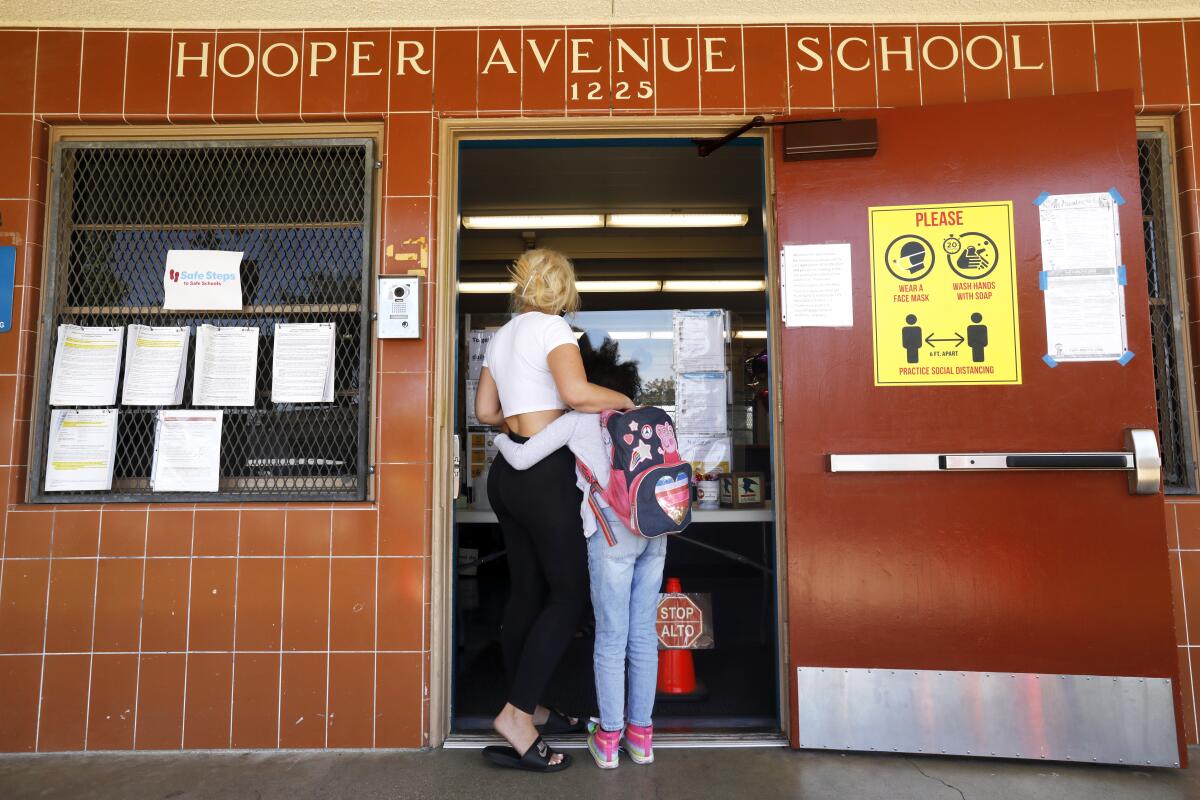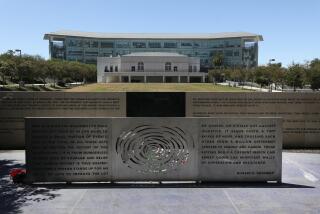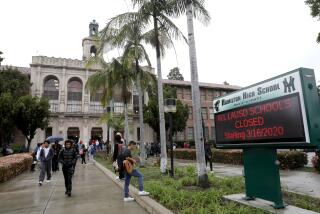A huge L.A. school budget spurs high-stakes recovery effort to boost achievement

- Share via
With a record $20-billion operating budget for the upcoming academic year, the L.A. Unified School District board is promising students and parents a reshaped, reinvigorated experience this fall, with thousands of new workers to teach, counsel and sanitize.
The sweeping effort seeks to undue the harms of pandemic-forced school closures and make lasting progress over the next several years. But it also raises questions about what specifically the nation’s second-largest school system is preparing to deliver to its students in this high-stakes endeavor.
Officials have laid out a strategy to hire 930 psychologists and psychiatric social workers, an increase of more than 80%; 2,190 teachers, an increase of 8%; and 770 custodial workers, a 25% increase. And these numbers don’t include expected hiring in after-school and summer enrichment programs.
District officials estimate that spending has increased over the past three years to more than $24,000 per student from less than $17,000. While the permanence of this prosperity is uncertain, spending down available dollars within required timelines could prove a challenge given widespread teacher and specialty workforce shortages.
The funding allows for every school to have a nurse or at least full-time nursing services as well as full-time mental-health counseling. New teachers will be hired to focus especially on reading and math in the early grades — and especially at schools where students are struggling. Improving algebra skills in middle and high school also will be targeted. And there’s likely to be incremental class-size reduction across the board — in line with pledges made to settle the 2019 teachers strike. These pledges were contingent on the availability of new funding.
One funding source is record state revenue — courtesy of taxes paid by wealthier residents who fared well financially during the pandemic. Some of this aid comes as “one-time” dollars; other portions as ongoing funding.
The other major source is state and federal COVID-relief aid. The deaths and financial burden of the pandemic hit especially hard among low-income families — who account for about 80% of L.A. Unified students — and Black and Latino families — about 82% of enrollment. Students in these families also frequently grappled with barriers to online learning, such as poor internet access and limited opportunities at home to complete schoolwork.
“From crisis comes a once-in-a-lifetime chance to make things meaningfully better for the children we serve,” L.A. schools Supt. Austin Beutner said in a statement. The spending plan, he added, represents “the values of our organization, and it places students first. Schools will have the largest increase in the number of teachers, counselors and custodians in more than a generation. All will provide services to directly benefit students.”
Beutner is stepping down June 30, so the work immediately ahead will be led by Interim Supt. Megan Reilly, who has been the district’s No. 2 administrator.
For L.A. Unified — and some other school systems that serve mostly students from low-income families — the hiring represents the biggest expansion since the latter 1990s, when the state pushed through incentives that reduced class sizes from about 30 students to about 20 in kindergarten through third grade. And, for a time at least, schools will have a level of resources unfamiliar since before Proposition 13 cut property taxes and limited tax increases in 1978.
District leaders envision a fall scenario in which campuses are flooded with resources like at no time in recent memory — smaller classes, tutors everywhere and counselors rushing to help at any sign of unease. And students — perhaps in masks — will move through spotless hallways on their way to sanitized classrooms filled with purified air.
The challenge for district leadership will be ensuring that billions of dollars get to the students with the greatest needs — those with disabilities, falling grades, mental health struggles or barriers to online learning.
The $20-billion budget figure is difficult to compare to previous years because pandemic funding arrived from various sources, some of it spent on purposes not normally included in budget totals from previous years, such as COVID-related upgrades to ventilation systems. Such building upgrades would normally be paid for with school-bond proceeds. Meanwhile, the district used bond revenue to quickly purchase computers for students to use at home.
Before the pandemic, in 2018-19, the district budget was reported as about $7.6 billion. The just-approved budget, presented Tuesday as $20 billion, does not represent a three-fold increase. A more direct comparison would probably generate a current figure closer to $13 billion, although that too is an estimate. Beutner said Wednesday that staff is preparing something more close to an “apples-to-apples” comparison.
By any yardstick, the increase is huge.
A coalition of community groups called the Equity Alliance for LA’s Kids praised district leaders for prioritizing those students and schools most in need of extra help,
Some advocates, however, are expressing early disappointment with the district’s recovery effort, faulting officials for failing to reach agreement with the teachers union on an extended school day or extended school year. They also worry that tutoring opportunities could be limited despite a fat line item for that purpose.
“When schools start in August, they should look dramatically different,” said Jay Artis-Wright, executive director of the group Parent Revolution, which has assisted parents in a lawsuit over the district’s alleged deficiencies in remote learning. “LAUSD has already said that more instructional time is what kids need. But even with historic resources, the district failed to win that for all children.”
The leader of another group said that the budget’s development and approval lacked transparency, genuine parent engagement and a clear articulation of vision and goals.
“While the budget may have a lot of interesting and promising investments, we don’t know as a whole how they are cohesively the best for our children,” said Ana Ponce, executive director of Great Public Schools Now. “It’s like grocery shopping for dinner and getting lots of items that are delicious, but getting home and realizing none of them fit together to make an actual meal.”
Officials have acknowledged the murkiness of the budget process and tried to make Tuesday’s presentation more readily understandable. In addition, the Board of Education approved specific five-year goals that, based on the district’s past performance, are ambitious. Developing them into an action plan is a next step.
Even amid the largesse, the budget proposal included a warning that, long-term, the district remains on a path toward shortfalls.
“L.A. Unified has had and continues to have a structural deficit,” the report stated. “As revenues continue to decrease due to enrollment decline, expenditures have not been reduced proportionately. Though the budget is balanced, a significant amount of fund balance is being drawn upon over the multi-year projection.”
Board member Tanya Ortiz Franklin questioned whether the spending is sustainable. She suggested lowering the hiring target from about 6,000 to 4,000, but her cautionary note was not taken up.
Franklin ultimately joined other board members in approving additional spending — $40 million more for preschool expansion: $56.7 million to further enhance recently expanded programs for Black students; $10 million for “partnerships” with Indigenous organizations and tribes to support Indigenous students; an additional $2 million to “advance the rights of students and employees” whose background is Asian American, Native Hawaiian, Pacific Islander, Arab, Middle Eastern, Muslim or South Asian.
A vote to further diminish school police narrowly failed, which disappointed advocates from the group Students Deserve, who successfully lobbied for steep cuts last year.
“The commitment to invest $56.7 million into Black student achievement is a historic step for LAUSD to prioritize this much-deserved care and attention for its Black students,” said Sierra Leone Anderson, a rising sophomore at Girls Academic Leadership Academy. “But the failure to make even a small cut to school police in this budget perpetuates the problems of systemic racism and the criminalization of Black students.”
District surveys have shown substantial support for maintaining the school police department.
More to Read
Sign up for Essential California
The most important California stories and recommendations in your inbox every morning.
You may occasionally receive promotional content from the Los Angeles Times.











